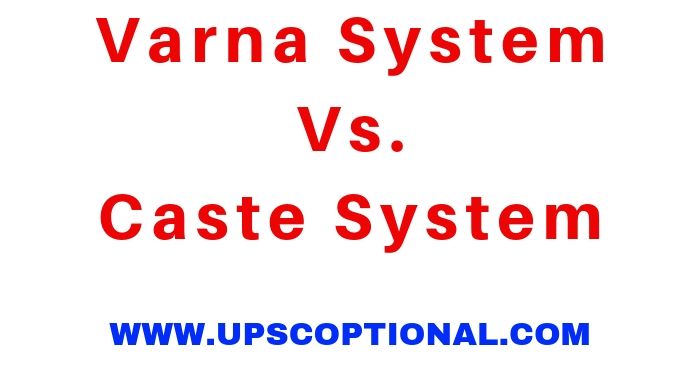What is the difference between Varna System and Caste System ?
Varna and Caste are two different concepts which are erroneously considered as synonymous. Describe their characteristic features and critically examine the references available in Hindu Shastras in this connection.
Ans – Distinction between Varna and Caste : –
1. Literal Distinction – Caste and Varna are completely different from each other. The difference in their literal meaning shows that Jati is evolved from a Sanskrit root ‘jaha’ meaning to be born. Thus caste means birth. On the other hand, Varna means to select or choose. In this way, caste is determined at birth whereas Varna is acquired by a person according to his nature.
2. Caste is fundamental of birth, Varna a fundamental of action. Thus caste is based upon birth while Varna is on action. In the caste system an uneducated Brahman is respected while an educated Shudra is looked down upon. A Brahmana is respected under the Varna System only if he has acquired knowledge and imparts it to others. In the history of Dharma Shastra Shri P V Kane writes that the idea of Varna mainly lays emphasis on the ethical and intellectual capabilities of man. In the caste system special importance is given to birth rights and respect enjoyed on that account.
3. Varna System is flexible while caste is a rigid one. The Varna system was a flexible and changing system. There are many examples of change in Varna and Inter- Varna marriages during and even after Vedic period. The Kshatriya Vishvamitra became by birth and Kshatriya by action. The same thing happened to Indra.
In the Mahabharata there is a mention of Devaki, Sidhudip and and Vithavya becoming Brahamans, and there are similar instances in the Bhagwat Purana. In the Padma Purana we have a mention of low born Vyas and Vaishya Vashistha becoming Brahamans. There are numerous examples of inter-Varna marriages in the Mahabharata. Kshatriya king Yayati married the Brahaman Devayani while Dushyant married Shakuntala. Although Shantanu was a Kshatriya, he married low born satyavati. Caste system forbids marriage among different castes, each caste considering marriage rigid if these are in the same caste itself.
4. NUMBER OF VARNA AND CASTE. There is a vast difference in the number of Varna and caste. Varnas are only four in numbers whereas Castes are large in numbers. In the 10th mantra of the Rig Veda we find meaning that the Brahamans does the work of the mouth in giving knowledge. The Kshatriya is comparable to the arms because he defends society, the Shudra work like the feet. Thus, there were four Varnas. On the other hand, Rose has put the number of castes at 400, on the authority of Census reports.
5. Risley, Ketan, Hutton, and Ghurye have named the following Characteristics of caste-
i) It is fundamental in birth. Its membership cannot be assumed through any other medium.
ii) Members can not marry outside their own caste
iii) In most mutual exchange of foodstuffs is restricted to the caste.
iv) The conduct of most castes is determined.
v) The castes believe their origin to be in some first person of God.
vi) Almost all castes have their own laws the infringement of which leads to expulsion from castes.






